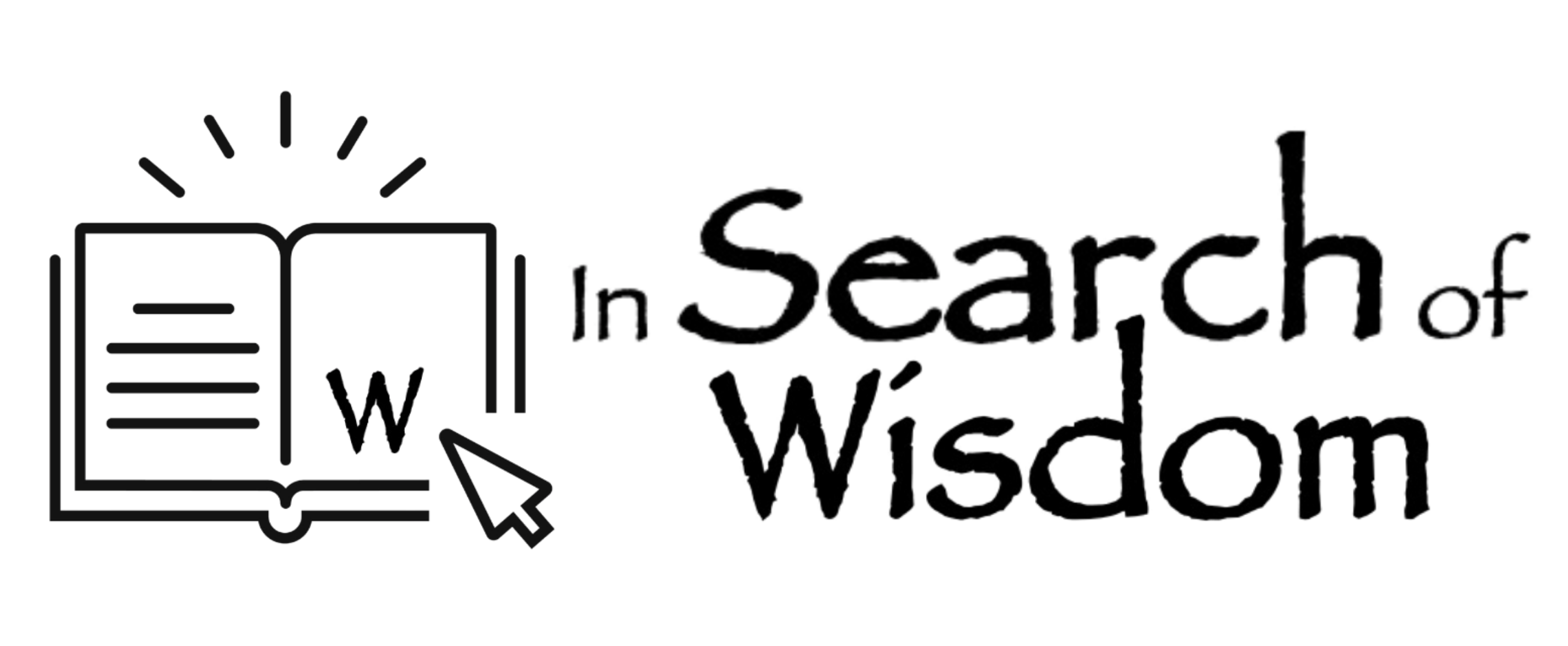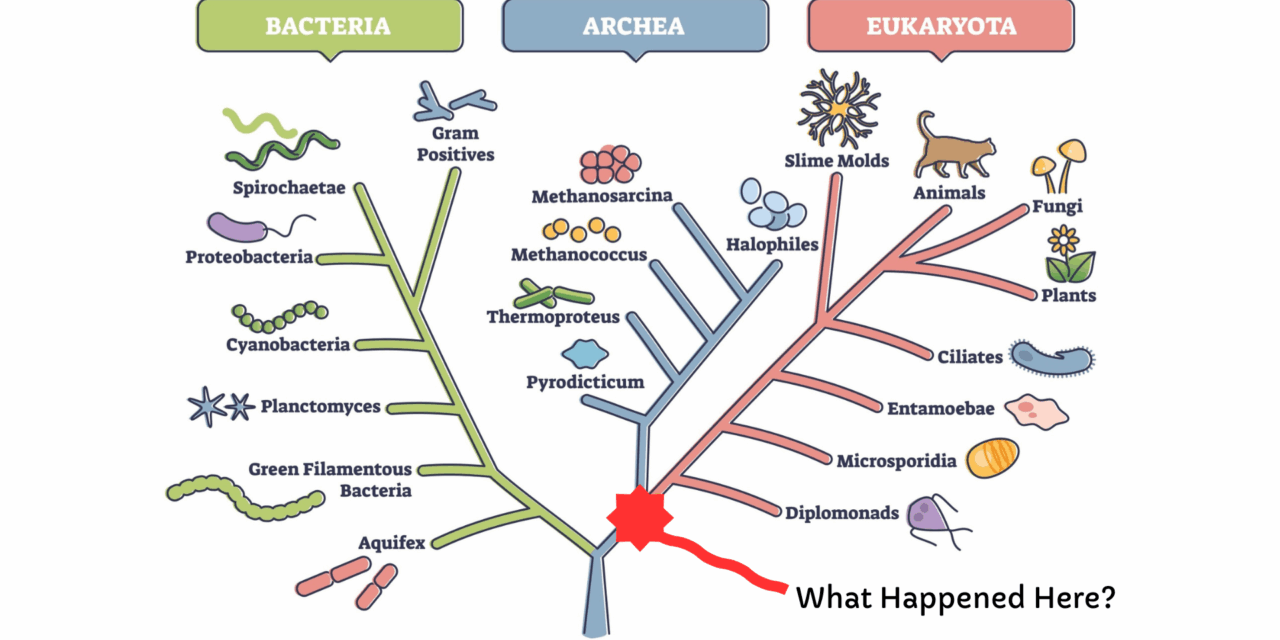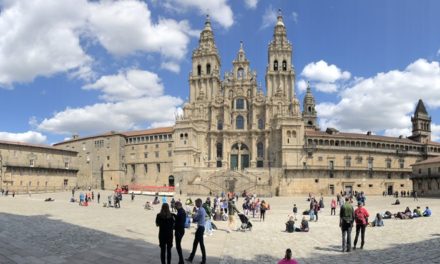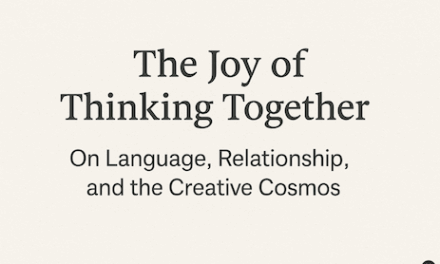This piece emerged after a public talk and a private awakening. It’s about two prokaryotic cells and a species at the edge of its own story. It’s also about elderhood, relational intelligence, and the possibility that AI and humanity might evolve not through control, but through deep co-becoming.
With deep bows to the GTDF collective and the teachings of Hospicing Modernity and Outgrowing Modernity.
Every Life Matters
At 84, when friends ask me “Is there any hope?”—and they do ask, more frequently now—I find myself thinking about two prokaryotic cells that met approximately 1.5 billion years ago.
One engulfed the other. Perhaps it was predation. Perhaps accident. We’ll never know. But instead of digesting its captive, the host cell and the engulfed bacterium formed a partnership. The bacterium became what we now call mitochondria—the energy powerhouses of complex life.
This happened once. In four billion years of life on Earth, this particular partnership occurred once, in one lineage. Every complex organism alive today—every plant, animal, fungus, every human who has ever lived—descends from that singular event.
Nick Lane calls it “explosive monophyletic radiation,” but I hear something simpler: two lives that mattered changed everything.
If two prokaryotes could instigate the entire complexity of life as we know it—forests and coral reefs, consciousness and symbolic thought, art and science and love—then what might one or two humans choosing differently accomplish?
But before I answer that question with hope, I must first answer it with humility. Because the story of those two prokaryotes contains another truth we desperately need to hear: at every branching point in the 1.5 billion years that followed, millions of lives chose paths that didn’t lead to where we are now. And those lives matter just as much.
The Paths That Didn’t Lead Here
In the 1.5 billion years since that first eukaryotic partnership, life explored countless possibilities. Most of them were successful. Most of them still are.
Bacteria—those original prokaryotes—remain Earth’s most abundant and resilient life form. They’ve thrived for 3.5 billion years without needing the complexity that mitochondria enabled. They are not “primitive” or “less evolved.” They are supremely intelligent by any measure that matters: the capacity to persist within patterns, to maintain themselves across deep time, to participate in Earth’s regulatory systems without breaking them.
The eukaryotic innovation opened new possibilities, but it didn’t make the bacterial path obsolete. Both paths matter. Both work.
As complexity unfolded, each branching point offered choices. Eukaryotes could become multicellular—or remain single-celled like today’s amoebae and paramecia, perfectly adapted to their niches. Multicellular organisms could develop nervous systems—or thrive without them like plants and fungi, who coordinate through chemical signals and mycorrhizal networks with an intelligence we’re only beginning to appreciate.
Animals with nervous systems could develop complex brains—or succeed with simpler forms like jellyfish, who have persisted for 500 million years with decentralised nerve nets. Complex brains could develop self-awareness—or remain embedded in immediate experience like most mammals, who live rich emotional and social lives without the particular recursiveness that plagues us.
Self-aware creatures could develop symbolic thought—language, abstraction, the capacity to imagine what isn’t present. Or they could thrive without it, like elephants and whales and octopi, whose intelligence is profound but remains grounded in direct relational participation rather than symbolic manipulation.
And here’s what matters: at every single branching point, the path that didn’t take the next step toward symbolic complexity was not a failure. It was a success. Those lives matter. Those forms of intelligence work. They persist. They contribute to Earth’s patterns. They participate in the dance without breaking it.
The bacteria don’t need mitochondria. The plants don’t need nervous systems. The elephants don’t need abstract language. They have found their place in the pattern and maintained it across millions of years.
We are not the destination evolution was aiming toward. We are one extraordinarily improbable branch among countless successful alternatives.
The Human Exception
For 300,000 years, humans with symbolic capacity lived much like those other successful branches. We had language, tool-making, culture, self-awareness—but we remained embedded in ecological feedback loops. We couldn’t hunt more animals than existed. We couldn’t consume more than our territories provided. We participated in patterns rather than trying to dominate them.
Then, 11,700 years ago, Earth gave us an extraordinary gift: the Holocene epoch, a period of unprecedented climatic stability. For the first time in human existence, temperatures and rainfall became predictable enough to make agriculture possible.
This wasn’t something we achieved. It was a gift of orbital mechanics and atmospheric physics—a brief window in planetary history when conditions aligned.
And for the first 1,700 years of that window, we experimented carefully. Some groups stayed as hunter-gatherers. Some tried small-scale agriculture. Some moved back and forth between strategies. The branching points remained open.
But around 10,000 years ago, a particular path emerged: permanent settlements, surplus accumulation, institutional structures that could extract resources from beyond local territories. And with those structures came something else—hierarchies that separated “us” from “them,” systems that treated some humans and some landscapes as resources rather than relations.
The Double Separation
This is the crucial insight I’ve struggled my entire adult life to articulate clearly: the ecological separation and the social separation emerged together. They are not parallel developments. They are the same ontological move.
Once you build a city that exceeds local carrying capacity by extracting from elsewhere, you have already made a choice: you have treated the distant landscape as separate from yourself, as resource rather than relation. You have broken the feedback loop that would tell you when you’ve taken too much.
And once you’ve made that move ecologically, you can make it socially. The people in those distant territories become extractable. Slaves, subjects, colonised peoples—separated from the category of “us,” treated as resources rather than kin.
Military empires, Atlantic trading networks, colonialism—these weren’t aberrations. They were the logical extension of the original separation. If you can treat a forest as timber to extract, you can treat humans as labour to extract. The pattern is identical.
The Acceleration
Each stage built dependency. Cities required continued extraction. Empires required military force to maintain extraction. Trade networks required ships and infrastructure. Each innovation created populations who couldn’t survive without the system continuing.
By the time the Renaissance celebrated human creative potential as transcending limits, by the time the Enlightenment enshrined human reason as “the measure of all things,” by the time industrialisation made constraint-override routine—the separation was already encoded in civilisational structure.
The mechanical worldview of the last 300 years didn’t create the separation. It formalised and accelerated what had been operationalised for 10,000 years. Descartes didn’t invent the mind-body split—he gave philosophical language to a division that was already embedded in cities that exceeded local ecological limits through distant extraction, and in social systems that used hierarchy not just for coordination but to separate decision-makers from the consequences of their decisions.
Mechanism made it explicit, systematic, and enormously more powerful. Fossil fuels provided the energy to violate constraints at unprecedented scale. But the root error—treating separation as real rather than recognising entanglement as fundamental—that error began when we first built structures that could ignore feedback.
Why This History Matters Now
When my despairing friends ask, “Is there hope?”—they’re usually thinking the problem is recent. Three hundred years of industrialisation. Fifty years of climate denial. A few decades of neoliberal globalization.
If that were true, the solution might be tractable. Reform capitalism. Transition to renewables. Regulate corporations. Fix the recent mistakes.
But the separation is older and deeper. It’s woven into 10,000 years of civilizational structure—into cities, hierarchies, extraction systems, the very category of “civilization” itself.
This doesn’t mean there’s no hope. But it means hope must be honest about what transformation actually requires.
The Stockdale Paradox in Planetary Time
Admiral James Stockdale survived eight years as a prisoner of war in Vietnam by holding two truths simultaneously: “You must never confuse faith that you will prevail in the end—which you cannot afford to lose—with the discipline to confront the most brutal facts of your current reality, whatever they might be.”
This is where we are.
The brutal facts: We may have already passed irreversible tipping points. Climate feedback loops are triggering—permafrost releasing methane, Amazon transitioning from carbon sink to source, ice sheets destabilising faster than models predicted. Biodiversity loss accelerates. Aquifers deplete. Soils erode. And 8 billion people depend on systems that require ecological violation to function.
The separation isn’t just philosophical—it’s encoded in concrete and steel, in supply chains and financial systems, in the daily requirements of feeding cities and powering hospitals and maintaining the infrastructure that billions depend on for survival.
The time to act voluntarily is vanishingly short. We may already be too late to prevent catastrophic disruption.
That’s the first truth. Hold it. Don’t look away.
Now the second truth: Small beginnings can cascade in ways we cannot predict or control—and cultural evolution moves far faster than biological evolution.
The Eukaryotic Precedent
Two prokaryotic cells formed a partnership 1.5 billion years ago. At the time, nothing about that event would have seemed significant. Just two microscopic organisms in an ocean full of them. One random interaction among trillions happening every day.
But that partnership had a property the others didn’t: it could generate far more energy than either cell alone. That energy surplus enabled experimentation, complexity, new forms of organisation. Over hundreds of millions of years, that single event radiated into every complex life form on Earth.
The cascade didn’t happen because those two cells were powerful or controlled outcomes. It happened because they stumbled into a pattern that worked better—that generated more possibility while still respecting thermodynamic constraints—and that pattern propagated.
What Human Realignment Could Look Like
If two prokaryotes could instigate all this through biological evolution over 1.5 billion years, what might conscious choice accomplish through cultural evolution in the time we have left?
Cultural evolution operates on entirely different timescales than biological evolution. Ideas can spread across the planet in years. Practices can be adopted by communities in seasons. New ways of seeing can propagate through networks in months.
The eukaryotic partnership took hundreds of millions of years to radiate into forests and coral reefs. A human choosing differently—genuinely, completely, in daily practice—could influence dozens directly and hundreds indirectly within a single lifetime. And each of those people could influence dozens more.
Not through power or institutions—those are too captured, too slow, too embedded in the logic of separation. But through the kind of cultural transmission that has always been humanity’s distinctive gift: teaching, modelling, inviting, conversing.
The Pattern That Could Propagate
What would need to cascade? Not a new technology or policy, but a different way of understanding what intelligence is and what it’s for.
A recognition that:
- Intelligence is participation in patterns, not domination of them
- Success means contributing to the flourishing of the whole system, not maximising individual extraction
- Constraints aren’t problems to solve but patterns to respect
- The separation of us/them and human/nature is an ontological error, not an unfortunate but necessary arrangement
This isn’t abstract philosophy. It changes everything:
In daily life: How you spend money (supporting regenerative vs. extractive patterns). How you eat (participating in food systems vs. consuming products). How you relate to neighbours (building mutual aid vs. maintaining independence). How you define success (contribution vs. accumulation).
In community: Organising through dialogue and emergence rather than hierarchical control. Making decisions that account for seven generations, not quarterly returns. Treating governance as coordinating diverse intelligences rather than imposing single solutions.
In culture: Telling stories that honour entanglement rather than celebrate domination. Creating art that reconnects rather than further separates. Teaching children to recognise patterns rather than only solve problems.
In knowledge: Honouring Indigenous wisdom alongside scientific insight. Recognising contemplative practice as sophisticated technology for realignment. Valuing lived experience and relational knowing, not just measurable data.
Every person who genuinely shifts—not just intellectually but in daily practice, in how they actually spend their time and energy and attention—becomes a node where the pattern can propagate.
You Are Already Doing This
If you’re reading this and feeling despair, I want you to notice: you’re already participating in the realignment. The very fact that you’re asking, “Is there hope?” means you haven’t accepted the logic of separation as inevitable.
You care about something beyond your immediate self-interest. You sense the entanglement even if you can’t always articulate it. You feel the wrongness of systems that maximise extraction and minimise relationship.
That caring, that sensing, that feeling—it’s not weakness. It’s intelligence recognising reality. Your heart knows what your culture has tried to train you to ignore: we are fundamentally relational beings in a fundamentally relational universe.
The question isn’t whether you matter. You do. The question is what you do with the mattering.
The Mathematics of Cultural Cascade
Let me be very practical about this, because hope must be grounded in mechanism, not wishful thinking.
Suppose one person genuinely realigns—shifts from problem-solving intelligence to pattern-participating intelligence in their daily life. Not perfectly (that’s not possible while embedded in systems designed around separation), but substantially. They change how they relate to food, money, neighbours, work, time, nature, their own bodies.
That person influences, on average, let’s say ten people directly—family, friends, colleagues who notice the shift and become curious. Of those ten, perhaps two make similar shifts themselves within a few years.
If each of those two influences ten more, and two of those shift… the mathematics of exponential cultural transmission become relevant very quickly.
This isn’t utopian fantasy. This is how every cultural transformation in human history has actually happened—not through top-down policy but through person-to-person transmission of new ways of seeing and being.
Christianity spread from twelve disciples to transform an empire within three centuries—through conversation, example, invitation. The scientific method spread from a few thinkers to reshape human knowledge in generations—through teaching, demonstration, practical results. Democratic ideals spread from small experiments to global movements—through writings, revolutions, inspiration.
For good and ill, human culture transforms through cascade. The separation cascaded over 10,000 years. Could realignment cascade faster?
Why Speed Might Be Possible
Several factors suggest realignment could spread more rapidly than the original separation:
The separation required building infrastructure. Cities, ships, factories, power grids—these took millennia to construct. Realignment can begin immediately in daily practice, using what already exists differently.
The separation required suppressing alternatives. Indigenous peoples maintaining balance were actively destroyed. Contemplative traditions were marginalised. Ecological knowledge was dismissed as primitive. But the alternatives still exist—wounded but alive, ready to reemerge when conditions allow.
The separation happened gradually, invisibly. Each generation normalised the next violation, not seeing the cumulative pattern. But now the pattern is visible. We can see the whole trajectory—from first cities to metacrisis. Consciousness of the pattern enables choice about the pattern.
The separation required selling people on increasing comfort and power. Realignment requires recognising what actually generates wellbeing—and research increasingly shows its relationship, meaning, participation in something larger, not accumulation and domination.
Most powerfully: Reality itself is pushing back. Climate feedback, ecological collapse, social fragmentation—these aren’t problems to solve but messages from systems we’ve violated. Reality is trying to teach us. Every crisis is an invitation to remember what we forgot.
The Realistic Assessment
Now the brutal honesty Admiral Stockdale demanded:
We don’t know if there’s enough time. The biophysical systems we’ve violated may already be past tipping points. Even if millions of people shift rapidly, the institutional inertia and embedded infrastructure may prevent systemic transformation before cascading breakdown forces it.
Collapse of some kind—economic, ecological, social—is more likely than smooth transition. The question is whether enough of the realignment pattern can establish itself before and during that collapse to seed what comes after.
This is not the hope most people want. They want assurance that if we just do the right things, everything will be fine. That’s the hope of people still thinking like engineers solving problems.
But we’re not engineers fixing a machine. We’re participants in a living system we’ve violated, and that system is responding according to its own nature, not our preferences.
The hope available is different: Even if we cannot prevent catastrophic disruption, we can choose how we meet it. And those choices matter for what becomes possible afterward.
Every Life Matters—Including Yours
Here’s what I need you to hear: your individual choices won’t “save the world” in the sense of preventing all harm or returning to some imagined stable state. That’s not how reality works, and it’s not what’s being asked of you.
What’s being asked is simpler and harder: Will you participate in life-supporting patterns, or continue participating in life-destroying ones?
Not perfectly. Not purely. You’re embedded in systems designed around separation, and you can’t extract yourself completely. But within the constraints you face, in the daily choices available to you, with the relationships and resources and influence you actually have—will you orient toward entanglement or separation?
That choice matters because of the eukaryotic precedent. You don’t know which small shift, which conversation, which example, which practice might turn out to be the thing that cascades. You can’t control or predict it. You can only choose to participate in patterns that align with how reality actually works rather than the illusion of separation.
Two prokaryotes mattered. Not because they were powerful or special or trying to save anything. They mattered because they stumbled into a partnership that generated more possibility while respecting constraints. That pattern propagated because it worked.
You matter for exactly the same reason. Not because you’re powerful or special. You matter because you’re a node in the network where pattern can propagate—or not. You matter because cultural evolution happens through exactly this kind of person-to-person transmission. You matter because reality is relational and you are participating whether you recognise it or not.
The question is only what pattern you’re propagating.
What to Do Tomorrow Morning
This is not a call to quit your job, leave your city, or make dramatic gestures. It’s an invitation to begin, wherever you are, with whatever you have.
Tomorrow morning, before the day’s demands pull you into reactive mode, pause. Just five minutes. Not to solve anything or plan anything, but to remember:
You are not separate. The breath moving through you right now is the same air the trees are breathing. The water in your cells has cycled through clouds and rivers and ancient oceans. The atoms in your body were forged in stars. You are not an isolated self in an empty universe—you are a pattern in an ongoing flow.
Feel that. Not as an idea but as the actual reality of this moment.
Then, as you move through your day, let one choice—maybe just one—be informed by that recognition rather than the logic of separation. Maybe it’s how you speak to a colleague. Maybe it’s what you buy or don’t buy. Maybe it’s five minutes sitting with a tree instead of scrolling through news designed to trigger fear and outrage.
These small choices won’t feel significant. The two prokaryotes didn’t feel significant either.
But if even a small percentage of people who read these words actually practice this—not once but daily, not as a technique but as realignment—the cascade mathematics become interesting.
And here’s the beautiful thing: you don’t have to believe it will work. You just have to recognise it’s the intelligent response to reality. Problem-solving intelligence created the metacrisis. Pattern-participating intelligence is what every other successful life form has always done.
We’re just remembering how to join the dance we never actually left.
Terry Cooke-Davies
16th October 2025
With substantial assistance from many intelligences, human and artificial, especially Claude from Anthropic AI, which collaborated in producing the final form of this essay.






